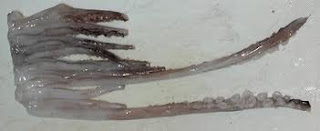Body Parts and Functions
Chromatophores: Spots that change size in order to change squid's color for camouflage or possibly communication
Pen: All that is left of the shell the squid's ancestor once had
Mantle and chromatophores
Pen: All that is left of the shell the squid's ancestor once had
Suction cups: Help the squid hold onto food
Tentacle: Longer than arms and only have suction cups on the tips; used to pass food to arms and then to mouth
Tentacles and arms
Suction cups
Gonad: Reproductive organ
Gills: Absorb oxygen from water
Heart: Circulates blood
Ink sac: Squid releases ink from this gland when it is in danger
Brain: Highly developed for an invertebrate
Siphon: Squirts out water so that the squid moves like a jet
Heart, ink sac, brain, and siphon
Beak: Takes in food; resembles a bird's beak
Evaluation
6 interesting facts:
- When a squid is threatened, it releases a cloud of ink to confuse predators and give it a chance to escape.
- Squid can be as small as a thumbnail or as large as a house.
- Squid sometimes feed on their own kind.
- About 6,000 metric tons of squid are taken yearly for human food and bait.
- Female squid produce 10-50 elongated egg strings, which each contain hundreds of eggs.
- In many species of squid, the parents will die soon after leaving the spawning ground.
The most disgusting part of the lab was how liquidy and smelly the squid was, but it was interesting to learn that the lenses from the eyes of larger squids were used by sailors as marbles. It was also fun (in a disgusting, yet entertaining sense) to remove the ink sac and paint with it. My least favorite part of the lab was that we did not get any gloves; it seemed a bit unsanitary. But overall, it was interesting to receive a fuller understanding of squids.










No comments:
Post a Comment